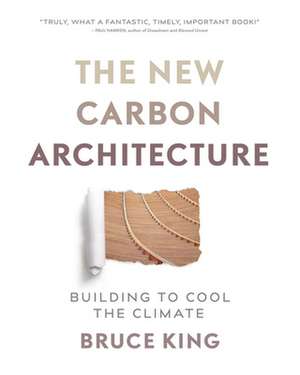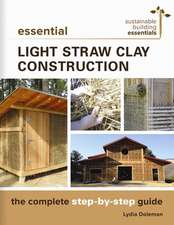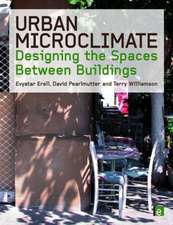New Carbon Architecture: Building to Cool the Planet
Autor Bruce Kingen Limba Engleză Paperback – 13 noi 2017
Preț: 180.09 lei
Nou
34.46€ • 37.42$ • 28.95£
Carte disponibilă
Livrare economică 01-15 aprilie
Livrare express 18-22 martie pentru 28.92 lei
Specificații
ISBN-10: 0865718687
Pagini: 160
Ilustrații: Color photos, B&W photos throughout
Dimensiuni: 203 x 254 x 16 mm
Greutate: 0.43 kg
Editura: New Society Publishers
Colecția New Society Publishers
Notă biografică
Textul de pe ultima copertă
SOAK UP CARBON INTO BEAUTIFUL, HEALTHY BUILDINGS THAT HEAL THE CLIMATE
We must go beyond building operations and address embodied carbon -- phasing out carbon emissions in building materials and construction by mid-century; this book illustrates how. -- EDWARD MAZRIA, Founder / CEO Architecture 2030
I recommend this book as a primer for anyone interested in combatting global climate change via building science. -- JERRY YUDELSON, PE, LEED Fellow, "The Godfather of Green" -- Wired Magazine and author, Reinventing Green Building
That same carbon atom that's wreaking havoc in the atmosphere is a building block for many great traditional and new building materials. The New Carbon Architecture shows us how in ways that are both practical and imaginative -- truly a resource for our times. -- NADAV MALIN, President, BuildingGreen, Inc.
LIKE NEVER BEFORE in history, buildings can become part of the climate solution. With biomimicry and innovation, we can pull huge amounts of carbon out of the atmosphere and lock it up as walls, roofs, foundations, and insulation. We can literally make buildings out of sky with a massive positive impact.
The New Carbon Architecture is a paradigm-shifting tour of the innovations in architecture and construction that are making this happen. Office towers built from advanced wood products; affordable, low-carbon concrete alternatives; plastic cleaned from the oceans and turned into building blocks. We can even grow insulation and bricks!
A tour de force from the leaders in the field, The New Carbon Architecture will fire the imagination of architects, engineers, builders, policy makers, and everyone else captivated by the possibility of architecture that heals the climate and produces safer, healthier, and more beautiful buildings.
BRUCE KING, a structural engineer for 35 years, is Founder and Director of the Ecological Building Network (EBNet) and author of Buildings of Earth and Straw, Making Better Concrete, and Design of Straw Bale Buildings. He lives in San Rafael, California.
With contributing authors in order of appearance:
ERIN MCDADE * ANN EDMINSTER * CATHERINE DE WOLF * KATHRINA SIMONEN *
BARBARA RODRIGUEZ DROGUETT * LARRY STRAIN * FRANCES YANG * ANDREW LAWRENCE * JASON GRANT * CHRIS MAGWOOD * MASSEY BURKE * CRAIG WHITE * FERNANDO MARTIRENA * PAUL JAQUIN * MIKHAIL DAVIS * WES SULLENS * WIL SRUBAR III *PETE WALKER * ANDREW THOMSON * DANIEL MASKELL
A project of the Ecological Building Network/US/Can 29.99 ISBN 978-0-86571-868-5
Cuprins
Acknowledgments
Preface: Buildings Made of Sky
Introduction
A Word about "Carbon"
1. Beyond Zero: The Time Value of Carbon by Erin McDade
A Global Carbon Limit
Buildings Are the Problem; Buildings Are the Solution
Zero by 2050
The Zero Net Carbon Gold Standard
Embodied Carbon: Getting to Real Zero
Emissions Now Hurt More than Emissions Later: The Relative Importance of Embodied Carbon
Embodied Carbon in the Future
The Time Value of Carbon
Zero Energy in a Nutshell by Ann V. Edminister
2. Counting Carbon: What We Know and How We Know It by Catherine De Wolf, Barbara Rodriguez Droguett, and Kathrina Simonen
Building Carbon Neutral
The Relative Impact of Embodied Carbon in Typical Buildings
Comparing Structural Materials
Comparing LCA Methods
Concrete
Steel
Wood
Other Structural Materials
Nonstructural Materials
Comparing the Embodied Carbon of Buildings
Getting to Zero: Embodied Carbon
3. Rebuild: What You Build Matters, What You Don't Build Matters More by Larry Strain
We Can't Build Our Way Out of This
Reuse: A Complete Strategy
Reducing Embodied Carbon
Reducing Operating Carbon: Renovation + Upgrade
Upgrading to Zero
Retrofit Opportunities
Energy Efficiency Opportunities
Net-zero Opportunities
Saving Embodied Carbon Opportunities
4. Wood: Like Never Before
Mass Timber Construction by Frances Yang and Andrew Lawrence
The Carbon Argument
So How Tall Can Timber Really Go?
Enter Cross-laminated Timber (CLT)
Stiffness
Fire
Acoustics
Seismic Performance
Beyond Carbon
The Future
Seeing the Forests for the Mass Timber by Jason Grant
5. Straw and Other Fibers: A Second Harvest with Chris Magwood and Massey Burke
Straw Bales and Straw Bale Panels
Prefabricated Straw Bale Wall Panels
Straw Blocks
Straw Panels
Bonded Plant Fiber Insulation Systems
The Planet's Sixth Carbon Sink: A Success Story by Craig White
6. Concrete: The Reinvention of Artificial Rock with Fernando Martirena and Paul Jaquin
What Is Concrete?
The Problem with Concrete
The Reinvention Is On
But First, Some Basics
Clay: The First Cement by Paul Jaquin
Historical Building Using Clay as a Binder
What Makes Clay Special?
Bonding in Clay
Sheets, Layers, and Assemblages
Sheets
Layers
The Assemblage
Friction
Suction
How Strong Is Clay Concrete?
Humidity Buffering and Thermal Mass
Future
Rethinking Cement by Fernando Martirena
More Ways to Reinvent Concrete
What About Reinforcing ¿ Steel and More
7. Plastic: So Great, So Awful ¿ Some New Directions
by Mikhail Davis, Wes Sullens, and Wil Srubar
Introduction
Biopolymers and Bioplastics
Plant Biopolymers
Animal Biopolymers
Bacterial Biopolymers
The Bioplastics Dilemma
Existing Plastics in the World
The Scale of the Plastics Problem: How Much Is Already Out There?
What To Do With All That Existing Plastic?
Barriers to Plastics Recovery and Recycling
Bright Spots for Plastics
What You Can Do: The Low-carbon Plastics Hierarchy
Guidelines: The Low-carbon Plastics Hierarchy
From Obstacles to Opportunities to Solutions: Can We Redeem Plastic?
Trash to Treasure: Can We Harvest the Existing Plastic Pollution from the Environment to Make New Products?
Carbon-loving Plastics: Can We Produce Plastics that Capture or Store Carbon?
Paths to Bio-based Plastics
Regenerative Agriculture
GHG to Plastic
Carbon-plastic Composites: Can We Put New Carbon into Old Plastic?
Closing the Loop: Can We Truly Manage Plastics in a Circular System?
8. To Your Health: The Health Benefits and Impacts of Natural Building Materials by Pete Walker, Andrew Thomson, and Daniel Maskell
Health Benefits
Moisture Buffering Materials
The Breathing Wall Concept: Vapor Permeability and Capillarity
Controlling Volatile Organic Compounds
Health Risks
Radioactivity
Silica Dust
Handling Lime
Protective Treatments
Concluding Comments
9. Size Matters: Can Buildings Be Too Tall? by Ann Edminster
The Height Problem
Aspects of the Problem
Ground Zero: Height as a Driver of Embodied Carbon
Will Transit Catch Up?
Middle Ground, Perhaps
Livability
Resiliency
Conclusions
Editor's Endnote
10. Technology and Localization: Trends at Play
Nanotechnology
Biotechnology and Biomimicry
Localization: The Convergence of Social and Technological Trends
Robotics, Artificial Intelligence, and 3-D Printing
11. Action Plan: Places to Intervene in a System
Places to Intervene in a System
Building Codes and Standards
Incentives
Research
Information Flows
A Price on Carbon
Necessary Afternote #1
Necessary Afternote #2
Necessary Afternote #3: Which System Are We Talking About?
Necessary Afternote #4: In Which the Republicans Make the Case
Afterword
Contributing Authors
Index
A Note about the Publisher














